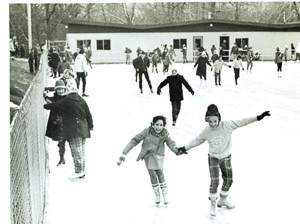Winter sports in Indianapolis in the 1950s were very limited. Most of my outdoor activity centered around sledding on Brown’s Hill ([southwest corner of Washington St and Emerson Ave.), building snow forts, and engaging in snowball fights. Once there was a strange sight of a cross-country skier slowly gliding across Pleasant Run Golf Course. However, there was one very popular sport — sliding across any patch of an icy surface, generally without skates.
On the north side of Ellenberger Park stands a large metal structure west of the swimming pool that once was filled with the laughter and cheers of ice skaters. Originally an open-air ice skating rink, the Ellenberger Ice Skating Rink was the first public facility of its kind in Indianapolis. Built by the Charles R. Beltz Co. at a cost of $91,000 (2015: $728,431), the 85 foot long by 185 foot wide artificial ice rink opened on November 19, 1961 and immediately became a popular destination. It was the culmination of a long love affair that had drawn residents of the city to the glistening blue-white surfaces.
Early ice skaters had limited options in Indianapolis. The frozen waters of the Canal provided a recreational space during the Civil War years, and later White River and Fall Creek were ice skating venues. The rough ice of these waterways made skating a challenge let alone the ever present danger of skaters breaking through the ice in deep waters. By the late 1860s, roller-skating rinks were being flooded and then frozen by an artificial process. The Indianapolis Skating Rink — “The Rink” — at the south west corner of Tennessee (Capitol) and Georgia offered such an indoor ice skating recreational space in the city.
Safer outdoor ice skating sites were provided with the use of the lagoons at Garfield Park, Riverside Park (Lake Sullivan), and South Grove golf courses. During the winter months in the ‘teens, the Indianapolis Parks Department sprinkled the ground at School No. 34 on the city’s south side and at Capitol Avenue and 24th Street on the north side until it froze over “with an even layer of ice,” and in the latter part of the decade a small dam was constructed on Pleasant Run at Emerson Avenue that created a “sheet of water” that when frozen over was available to skaters. In December 1920, the Indianapolis Parks Department created the first of several skating ponds by flooding the athletic field at Willard Park and freezing it.
The figure skating talents of three-time Olympic champion Sonja Henie and her subsequent appearance on the Hollywood silver screen and on tours — Sonja Henie Ice Revue — ensured the popularity of ice skating across the United States and especially in Indianapolis. In the fall of 1939 an ice-skating rink costing $200,000 (2015: $3,449,914) was installed in the newly completed State Fairgrounds Coliseum and the city’s first professional hockey game debuted on this ice on November 10 between the Indianapolis Capitals and the Syracuse Stars. L. S. Ayres & Co. promoted ice skating as a sport for the entire family with a newspaper ad “I Skate! You Skate! We All Skate!” featuring a clothing line and skates for “Mother,” “Daughter,” “Papa,” “Sister Sue,” and “Me, Too!” Billed as “Indianapolis Winter Wonderland,” individual skaters could use the Coliseum ice rink for 40ȼ (2015: $7) and ice skating Clubs — Blue Streak Skating Club and Figure Skating Club — were quickly formed. In addition to the Coliseum, the Iceland Skating Rink, 928 N. Pennsylvania St, offered another venue for the Glider Ice Skating Club, the Keen Kutters (for children), the Family Flyers, and the Gay Blades. In 1947 the city parks department flooded the tennis court at Christian Park to help meet the public demand for an additional skating arena.
The commitment to providing public ice skating venues in Indianapolis was assured with the opening of the Ellenberger Park Ice Skating Rink. After a decade of being an open-air facility, a roof was placed over the Ellenberger Rink “to insue skaters of good ice despite the elements” of winter. Later it was completely enclosed. By the late 70s the Indianapolis Parks Department had opened Perry Park Ice Rink, an enclosed facility, and southsiders were soon pirouetting across its glistening surface. Open-air ice skating at Krannert Pond, Lake Sullivan, and Eagle Creek Park continued to be popular sites into the 1980s. Families would drive to these free sites with children anxiously hoping to see the “green flag is flying” proclaiming safe ice. The Broad Ripple baby pool and the Holliday Park reflecting pool were also active ice skating venues.
For decades, Shirley Lake on Pleasant Run was a winter destination for east side ice skaters. Located south of 21st St. along Shadeland Av, skaters could often be seen skating at night under the glow of automobile headlights shining down on to the creek’s glistening icy surface from the banks above. Downtown Indianapolis briefly offered open-air ice skating rink in the east basin of the Soldiers and Sailors Monument on the Circle in the late 70s, and a decade later the new Pan American Plaza offered both indoor and outdoor ice skating surfaces.
The Ellenberger Ice Skating Rink closed after the 2008-09 season because of the cost in maintaining its aging ice making equipment. Over the last few years, its concrete floor has been the venue for roller derby matches and games of indoor soccer and youth league box lacrosse. I never quite mastered skating — ice or roller. As a super klutz, I’m glad that I had plenty of posterior padding.



